Dosing & Uses
Dosage Forms & Strengths
tablets
- 2mg
- 5mg
elixir
- 0.4mg/mL
Parkinson Disease
Initial: 1 mg PO first day, then increase by 2 mg q3-5days until reach 6-10 mg/days
Maintenance: 5-15 mg/day PO divided q6-8hr
Use SR product once stabilized on regular release product; when used with levodopa, generally use 3-6 mg/day in divided doses
Do not crush SR product
Monitor: IOP
Drug-induced Extrapyramidal Symptoms
1 mg/day PO initially; increase as necessary to maintenance range of 5-15 mg/day PO divided q6-8hr
Safety and efficacy not established
Nonanticholinergic antiparkinson agents should be considered first when treating Parkinson Disease (Beers Criteria)
Not recommended for preventing extrapyramidal symptoms
Parkinsonism
5-15 mg/day PO divided q6-8hr
Interactions
Interaction Checker
No Results

Contraindicated
Serious - Use Alternative
Significant - Monitor Closely
Minor

Contraindicated (0)
Serious - Use Alternative (6)
- glucagon
glucagon increases toxicity of trihexyphenidyl by Other (see comment). Avoid or Use Alternate Drug. Comment: Coadministration of anticholinergic drugs and glucagon increase the risk of gastrointestinal adverse reactions due to additive effects on inhibition of gastrointestinal motility. .
- glucagon intranasal
glucagon intranasal increases toxicity of trihexyphenidyl by Other (see comment). Avoid or Use Alternate Drug. Comment: Coadministration of anticholinergic drugs and glucagon increase the risk of gastrointestinal adverse reactions due to additive effects on inhibition of gastrointestinal motility. .
- glycopyrronium tosylate topical
glycopyrronium tosylate topical, trihexyphenidyl. Either increases effects of the other by pharmacodynamic synergism. Avoid or Use Alternate Drug. Coadministration of glycopyrronium tosylate topical with other anticholinergic medications may result in additive anticholinergic adverse effects.
- revefenacin
revefenacin and trihexyphenidyl both decrease cholinergic effects/transmission. Avoid or Use Alternate Drug. Coadministration may cause additive anticholinergic effects.
- secretin
trihexyphenidyl decreases effects of secretin by pharmacodynamic antagonism. Avoid or Use Alternate Drug. Concomitant use of anticholinergic drugs may cause a hyporesponse to stimulation testing with secretin. Discontinue anticholinergic drugs at least 5 half-lives before administering secretin.
- umeclidinium bromide/vilanterol inhaled
trihexyphenidyl, umeclidinium bromide/vilanterol inhaled. Either increases toxicity of the other by pharmacodynamic synergism. Avoid or Use Alternate Drug. Concomitant use with other anticholinergic-containing drugs may lead to additive anticholinergic adverse effects.
Monitor Closely (75)
- abobotulinumtoxinA
trihexyphenidyl increases effects of abobotulinumtoxinA by pharmacodynamic synergism. Use Caution/Monitor. Drugs with anticholinergic effects may potentiate botulinum toxin effects, which may result in excessive neuromuscular weakness and heighten systemic anticholinergic effects.
- aclidinium
aclidinium and trihexyphenidyl both decrease cholinergic effects/transmission. Use Caution/Monitor.
- amantadine
trihexyphenidyl, amantadine. Mechanism: pharmacodynamic synergism. Use Caution/Monitor. Potential for increased anticholinergic adverse effects.
- amitriptyline
trihexyphenidyl and amitriptyline both decrease cholinergic effects/transmission. Use Caution/Monitor. Potential for additive anticholinergic effects.
- amoxapine
trihexyphenidyl and amoxapine both decrease cholinergic effects/transmission. Use Caution/Monitor. Potential for additive anticholinergic effects.
- anticholinergic/sedative combos
anticholinergic/sedative combos and trihexyphenidyl both decrease cholinergic effects/transmission. Use Caution/Monitor. Potential for additive anticholinergic effects.
- atropine
atropine and trihexyphenidyl both decrease cholinergic effects/transmission. Use Caution/Monitor. Potential for additive anticholinergic effects.
- atropine IV/IM
atropine IV/IM and trihexyphenidyl both decrease cholinergic effects/transmission. Use Caution/Monitor.
- belladonna alkaloids
belladonna alkaloids and trihexyphenidyl both decrease cholinergic effects/transmission. Use Caution/Monitor. Potential for additive anticholinergic effects.
- belladonna and opium
belladonna and opium and trihexyphenidyl both decrease cholinergic effects/transmission. Use Caution/Monitor. Potential for additive anticholinergic effects.
- benztropine
benztropine and trihexyphenidyl both decrease cholinergic effects/transmission. Use Caution/Monitor. Potential for additive anticholinergic effects.
- chlorpromazine
trihexyphenidyl decreases levels of chlorpromazine by pharmacodynamic antagonism. Use Caution/Monitor.
chlorpromazine increases effects of trihexyphenidyl by pharmacodynamic synergism. Use Caution/Monitor. Potential for additive anticholinergic effects. - clomipramine
trihexyphenidyl and clomipramine both decrease cholinergic effects/transmission. Use Caution/Monitor. Potential for additive anticholinergic effects.
- clozapine
clozapine increases effects of trihexyphenidyl by pharmacodynamic synergism. Use Caution/Monitor. Potential for additive anticholinergic effects.
- cyclizine
cyclizine and trihexyphenidyl both decrease cholinergic effects/transmission. Use Caution/Monitor. Potential for additive anticholinergic effects.
- cyclobenzaprine
cyclobenzaprine and trihexyphenidyl both decrease cholinergic effects/transmission. Use Caution/Monitor. Potential for additive anticholinergic effects.
- darifenacin
darifenacin and trihexyphenidyl both decrease cholinergic effects/transmission. Use Caution/Monitor. Potential for additive anticholinergic effects.
- daxibotulinumtoxinA
trihexyphenidyl increases effects of daxibotulinumtoxinA by pharmacodynamic synergism. Use Caution/Monitor. Drugs with anticholinergic effects may potentiate botulinum toxin effects, which may result in excessive neuromuscular weakness and heighten systemic anticholinergic effects.
- desipramine
trihexyphenidyl and desipramine both decrease cholinergic effects/transmission. Use Caution/Monitor. Potential for additive anticholinergic effects.
- dicyclomine
dicyclomine and trihexyphenidyl both decrease cholinergic effects/transmission. Use Caution/Monitor. Potential for additive anticholinergic effects.
- dimenhydrinate
dimenhydrinate increases toxicity of trihexyphenidyl by pharmacodynamic synergism. Use Caution/Monitor. Additive anticholinergic effects.
- diphenhydramine
diphenhydramine and trihexyphenidyl both decrease cholinergic effects/transmission. Use Caution/Monitor. Potential for additive anticholinergic effects.
- donepezil
donepezil decreases effects of trihexyphenidyl by pharmacodynamic antagonism. Use Caution/Monitor.
- doxepin
trihexyphenidyl and doxepin both decrease cholinergic effects/transmission. Use Caution/Monitor. Potential for additive anticholinergic effects.
- droperidol
droperidol increases effects of trihexyphenidyl by pharmacodynamic synergism. Use Caution/Monitor. Potential for additive anticholinergic effects.
- fesoterodine
fesoterodine and trihexyphenidyl both decrease cholinergic effects/transmission. Use Caution/Monitor. Potential for additive anticholinergic effects.
- flavoxate
flavoxate and trihexyphenidyl both decrease cholinergic effects/transmission. Use Caution/Monitor. Potential for additive anticholinergic effects.
- fluphenazine
trihexyphenidyl decreases levels of fluphenazine by pharmacodynamic antagonism. Use Caution/Monitor.
fluphenazine increases effects of trihexyphenidyl by pharmacodynamic synergism. Use Caution/Monitor. Potential for additive anticholinergic effects. - galantamine
galantamine decreases effects of trihexyphenidyl by pharmacodynamic antagonism. Use Caution/Monitor.
- glycopyrrolate
glycopyrrolate and trihexyphenidyl both decrease cholinergic effects/transmission. Use Caution/Monitor. Potential for additive anticholinergic effects.
- glycopyrrolate inhaled
glycopyrrolate inhaled and trihexyphenidyl both decrease cholinergic effects/transmission. Use Caution/Monitor. Potential for additive anticholinergic effects.
- haloperidol
haloperidol increases effects of trihexyphenidyl by pharmacodynamic synergism. Use Caution/Monitor. Potential for additive anticholinergic effects.
- homatropine
homatropine and trihexyphenidyl both decrease cholinergic effects/transmission. Use Caution/Monitor. Potential for additive anticholinergic effects.
- hyoscyamine
hyoscyamine and trihexyphenidyl both decrease cholinergic effects/transmission. Use Caution/Monitor. Potential for additive anticholinergic effects.
- hyoscyamine spray
hyoscyamine spray and trihexyphenidyl both decrease cholinergic effects/transmission. Use Caution/Monitor.
- imipramine
trihexyphenidyl and imipramine both decrease cholinergic effects/transmission. Use Caution/Monitor. Potential for additive anticholinergic effects.
- incobotulinumtoxinA
trihexyphenidyl increases effects of incobotulinumtoxinA by pharmacodynamic synergism. Use Caution/Monitor. Drugs with anticholinergic effects may potentiate botulinum toxin effects, which may result in excessive neuromuscular weakness and heighten systemic anticholinergic effects.
- ipratropium
ipratropium and trihexyphenidyl both decrease cholinergic effects/transmission. Use Caution/Monitor. Potential for additive anticholinergic effects.
- letibotulinumtoxinA
trihexyphenidyl increases effects of letibotulinumtoxinA by pharmacodynamic synergism. Use Caution/Monitor. Drugs with anticholinergic effects may potentiate botulinum toxin effects, which may result in excessive neuromuscular weakness and heighten systemic anticholinergic effects.
- loxapine
trihexyphenidyl decreases levels of loxapine by inhibition of GI absorption. Applies only to oral form of both agents. Use Caution/Monitor.
trihexyphenidyl decreases levels of loxapine by pharmacodynamic antagonism. Use Caution/Monitor.
loxapine increases effects of trihexyphenidyl by pharmacodynamic synergism. Use Caution/Monitor. Potential for additive anticholinergic effects. - loxapine inhaled
loxapine inhaled increases effects of trihexyphenidyl by pharmacodynamic synergism. Use Caution/Monitor. Additive anticholinergic effects, possible hypoglycemia.
trihexyphenidyl decreases levels of loxapine inhaled by pharmacodynamic antagonism. Use Caution/Monitor. - maprotiline
trihexyphenidyl and maprotiline both decrease cholinergic effects/transmission. Use Caution/Monitor.
- meclizine
meclizine and trihexyphenidyl both decrease cholinergic effects/transmission. Use Caution/Monitor. Potential for additive anticholinergic effects.
- methscopolamine
methscopolamine and trihexyphenidyl both decrease cholinergic effects/transmission. Use Caution/Monitor. Potential for additive anticholinergic effects.
- nortriptyline
trihexyphenidyl and nortriptyline both decrease cholinergic effects/transmission. Use Caution/Monitor. Potential for additive anticholinergic effects.
- olanzapine
olanzapine increases effects of trihexyphenidyl by pharmacodynamic synergism. Use Caution/Monitor. Potential for additive anticholinergic effects.
- olanzapine/samidorphan
trihexyphenidyl, olanzapine/samidorphan. Either increases effects of the other by pharmacodynamic synergism. Use Caution/Monitor. Coadministration of olanzapine and other drugs with anticholinergic (antimuiscarinic) activity can increase risk for severe gastrointestinal adverse reactions related to hypomotility. .
- oliceridine
trihexyphenidyl increases toxicity of oliceridine by Other (see comment). Use Caution/Monitor. Comment: Anticholinergic drugs may increase risk of urinary retention and/or severe constipation, which may lead to paralytic ileus. Monitor for signs of urinary retention or reduced gastric motility if oliceridine is coadministered with anticholinergics.
- onabotulinumtoxinA
trihexyphenidyl increases effects of onabotulinumtoxinA by pharmacodynamic synergism. Use Caution/Monitor. Drugs with anticholinergic effects may potentiate botulinum toxin effects, which may result in excessive neuromuscular weakness and heighten systemic anticholinergic effects.
- orphenadrine
trihexyphenidyl and orphenadrine both decrease cholinergic effects/transmission. Use Caution/Monitor. Potential for additive anticholinergic effects.
- oxybutynin
oxybutynin and trihexyphenidyl both decrease cholinergic effects/transmission. Use Caution/Monitor. Potential for additive anticholinergic effects.
- oxybutynin topical
oxybutynin topical and trihexyphenidyl both decrease cholinergic effects/transmission. Use Caution/Monitor. Potential for additive anticholinergic effects.
- oxybutynin transdermal
oxybutynin transdermal and trihexyphenidyl both decrease cholinergic effects/transmission. Use Caution/Monitor. Potential for additive anticholinergic effects.
- perphenazine
trihexyphenidyl decreases levels of perphenazine by pharmacodynamic antagonism. Use Caution/Monitor.
perphenazine increases effects of trihexyphenidyl by pharmacodynamic synergism. Use Caution/Monitor. Potential for additive anticholinergic effects. - physostigmine
physostigmine increases and trihexyphenidyl decreases cholinergic effects/transmission. Effect of interaction is not clear, use caution. Use Caution/Monitor.
- pimozide
pimozide increases effects of trihexyphenidyl by pharmacodynamic synergism. Use Caution/Monitor. Potential for additive anticholinergic effects.
- prabotulinumtoxinA
trihexyphenidyl increases effects of prabotulinumtoxinA by pharmacodynamic synergism. Use Caution/Monitor. Drugs with anticholinergic effects may potentiate botulinum toxin effects, which may result in excessive neuromuscular weakness and heighten systemic anticholinergic effects.
- pramlintide
pramlintide, trihexyphenidyl. Either increases effects of the other by pharmacodynamic synergism. Use Caution/Monitor. Synergistic inhibition of GI motility.
- prochlorperazine
trihexyphenidyl decreases levels of prochlorperazine by pharmacodynamic antagonism. Use Caution/Monitor.
prochlorperazine increases effects of trihexyphenidyl by pharmacodynamic synergism. Use Caution/Monitor. Potential for additive anticholinergic effects. - promethazine
trihexyphenidyl decreases levels of promethazine by pharmacodynamic antagonism. Use Caution/Monitor.
promethazine increases effects of trihexyphenidyl by pharmacodynamic synergism. Use Caution/Monitor. Potential for additive anticholinergic effects. - propantheline
propantheline and trihexyphenidyl both decrease cholinergic effects/transmission. Use Caution/Monitor. Potential for additive anticholinergic effects.
- protriptyline
trihexyphenidyl and protriptyline both decrease cholinergic effects/transmission. Use Caution/Monitor. Potential for additive anticholinergic effects.
- quetiapine
quetiapine increases effects of trihexyphenidyl by pharmacodynamic synergism. Use Caution/Monitor. Potential for additive anticholinergic effects.
- rimabotulinumtoxinB
trihexyphenidyl increases effects of rimabotulinumtoxinB by pharmacodynamic synergism. Use Caution/Monitor. Drugs with anticholinergic effects may potentiate botulinum toxin effects, which may result in excessive neuromuscular weakness and heighten systemic anticholinergic effects.
- risperidone
risperidone increases effects of trihexyphenidyl by pharmacodynamic synergism. Use Caution/Monitor. Potential for additive anticholinergic effects.
- scopolamine
scopolamine and trihexyphenidyl both decrease cholinergic effects/transmission. Use Caution/Monitor. Potential for additive anticholinergic effects.
- solifenacin
solifenacin and trihexyphenidyl both decrease cholinergic effects/transmission. Use Caution/Monitor. Potential for additive anticholinergic effects.
- thioridazine
trihexyphenidyl decreases levels of thioridazine by pharmacodynamic antagonism. Use Caution/Monitor.
thioridazine increases effects of trihexyphenidyl by pharmacodynamic synergism. Use Caution/Monitor. Potential for additive anticholinergic effects. - thiothixene
thiothixene increases effects of trihexyphenidyl by pharmacodynamic synergism. Use Caution/Monitor. Potential for additive anticholinergic effects.
- tiotropium
tiotropium and trihexyphenidyl both decrease cholinergic effects/transmission. Use Caution/Monitor. Potential for additive anticholinergic effects.
- tolterodine
tolterodine and trihexyphenidyl both decrease cholinergic effects/transmission. Use Caution/Monitor. Potential for additive anticholinergic effects.
- tranylcypromine
tranylcypromine, trihexyphenidyl. Other (see comment). Use Caution/Monitor. Comment: Anti-parkinsonism drugs should be used with caution in patients receiving tranylcypromine since severe reactions have been reported.
- trifluoperazine
trihexyphenidyl decreases levels of trifluoperazine by pharmacodynamic antagonism. Use Caution/Monitor.
trifluoperazine increases effects of trihexyphenidyl by pharmacodynamic synergism. Use Caution/Monitor. Potential for additive anticholinergic effects. - trimipramine
trihexyphenidyl and trimipramine both decrease cholinergic effects/transmission. Use Caution/Monitor. Potential for additive anticholinergic effects.
- trospium chloride
trihexyphenidyl and trospium chloride both decrease cholinergic effects/transmission. Use Caution/Monitor. Potential for additive anticholinergic effects.
Minor (1)
- levodopa
trihexyphenidyl, levodopa. Other (see comment). Minor/Significance Unknown. Comment: Anticholinergic agents may enhance the therapeutic effects of levodopa; however, anticholinergic agents can exacerbate tardive dyskinesia. In high dosage, anticholinergics may decrease the effects of levodopa by delaying its GI absorption. .
Adverse Effects
>10%
Anticholinergic side effects (30-50%)
Rash
<1%
Suppurative parotitis
Hallucination
Paralytic ileus
Warnings
Contraindications
Hypersensitivity
Angle-closure glaucoma
Cautions
Exacerbation of parkinsonism, neuroleptic malignant syndrome, and withdrawal symptoms associated with therapy discontinuation or dose reduction; drug should be withdrawn gradually
Perform gonioscope evaluation before initiating treatment; monitor intraocular pressure closely at regular periodic intervals
Therapy may impair memory and exacerbate cognitive deficits in the elderly; may also cause delirium, hallucinations, and confusion when administered at high doses
Use extreme caution and monitor closely patients with liver, cardiac, kidney disorders, prostatic hyperplasia (urinary stricture), or with hypertension
Drug has atropine-like properties; use with caution in patients with glaucoma, obstructive disease of the gastrointestinal or genitourinary tracts and in elderly males with prostatic hypertrophy
Geriatric patients (>60 years) develop increased sensitivity to parasympathetic drugs; may precipitate incipient glaucoma in these patients
Not for use in patients with tardive dyskinesia unless it exists concomitantly with Parkinson disease; therapy may potentially exacerbate symptoms of tardive dyskinesia
May cause hyperthermia that can be fatal and anhidrosis; use with caution during exercise or hot weather, especially if administered concomitantly with anticholinergic agents to patients with CNS disease, alcoholics, or persons in a hot environment doing manual labor
Pregnancy & Lactation
Pregnancy Category: C
Lactation: no data; may inhibit lactation
Pregnancy Categories
A: Generally acceptable. Controlled studies in pregnant women show no evidence of fetal risk.
B: May be acceptable. Either animal studies show no risk but human studies not available or animal studies showed minor risks and human studies done and showed no risk. C: Use with caution if benefits outweigh risks. Animal studies show risk and human studies not available or neither animal nor human studies done. D: Use in LIFE-THREATENING emergencies when no safer drug available. Positive evidence of human fetal risk. X: Do not use in pregnancy. Risks involved outweigh potential benefits. Safer alternatives exist. NA: Information not available.Pharmacology
Mechanism of Action
Trihexyphenidyl inhibits the parasympathetic nervous system and has a relaxing effect on smooth muscles
Pharmacokinetics
Half-Life elimination: 33 hr
Onset: 1 hr
Peak effects: 1.3 hr
Duration: 6-12 hr
Metabolism: Unknown
Excretion: Urine and bile
Images
| BRAND | FORM. | UNIT PRICE | PILL IMAGE |
|---|---|---|---|
| trihexyphenidyl oral - | 2 mg tablet | 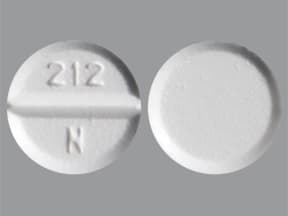 | |
| trihexyphenidyl oral - | 5 mg tablet | 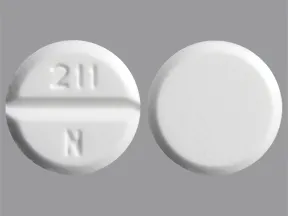 | |
| trihexyphenidyl oral - | 5 mg tablet | 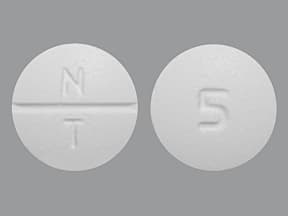 | |
| trihexyphenidyl oral - | 2 mg tablet | 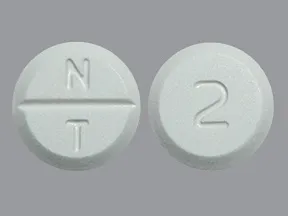 | |
| trihexyphenidyl oral - | 0.4 mg/mL solution |  | |
| trihexyphenidyl oral - | 2 mg tablet | 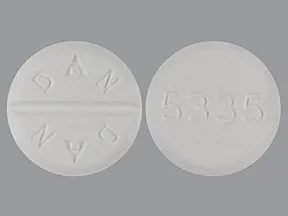 | |
| trihexyphenidyl oral - | 0.4 mg/mL solution | 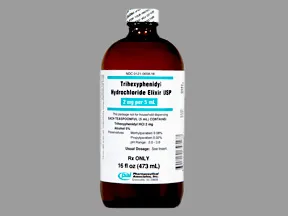 | |
| trihexyphenidyl oral - | 5 mg tablet |  |
Copyright © 2010 First DataBank, Inc.
Patient Handout
trihexyphenidyl oral
TRIHEXYPHENIDYL - ORAL
(try-hex-ee-FEH-nih-dill)
COMMON BRAND NAME(S): Artane
USES: Trihexyphenidyl is used to treat symptoms of Parkinson's disease or involuntary movements due to the side effects of certain psychiatric drugs (antipsychotics such as chlorpromazine/haloperidol). Trihexyphenidyl belongs to a class of medication called anticholinergics that work by blocking a certain natural substance (acetylcholine). This helps decrease muscle stiffness, sweating, and the production of saliva, and helps improve walking ability in people with Parkinson's disease.Anticholinergics can stop severe muscle spasms of the back, neck, and eyes that are sometimes caused by psychiatric drugs. It can also decrease other side effects such as muscle stiffness/rigidity (extrapyramidal signs-EPS). It is not helpful in treating movement problems caused by tardive dyskinesia and may worsen them.
HOW TO USE: Take this medication by mouth as directed by your doctor, usually 3 to 4 times a day with meals and at bedtime. Your doctor may start you at a low dose and increase your dose slowly to find the best dose for you. The dosage is based on your medical condition, age, and response to therapy.If you are using the liquid form of this medication, measure your dose with a special measuring spoon or device. Do not use a household spoon because it may not provide the correct dose.Take this medication regularly in order to get the most benefit from it. To help you remember, take it at the same times each day.Take this medication at least 1 hour before antacids containing magnesium, aluminum, or calcium. Allow at least 1-2 hours between doses of trihexyphenidyl and certain drugs for diarrhea (adsorbent antidiarrheals such as kaolin, pectin, attapulgite). Take this medication at least 2 hours after ketoconazole. Antacids and some drugs for diarrhea may prevent the full absorption of trihexyphenidyl, and this product may prevent the complete absorption of ketoconazole when these products are taken together.If you are taking this medication for side effects from another medication, your doctor may instruct you to take it on a regular schedule or only as needed. If you are taking this medication for Parkinson's disease, your doctor may change the dose of your other medications (such as levodopa). Follow your doctor's instructions closely.Though it helps many people, this medication may sometimes cause addiction. This risk may be higher if you have a substance use disorder (such as overuse of or addiction to drugs/alcohol). Do not increase your dose, take it more often, or use it for a longer time than prescribed. Properly stop the medication when so directed. Some conditions may become worse when the drug is suddenly stopped. Your dose may need to be gradually decreased.When used for an extended period, this medication may not work as well and may require different dosing. Talk with your doctor if this medication stops working well. Inform your doctor if your condition lasts or gets worse.
SIDE EFFECTS: Drowsiness, dizziness, constipation, flushing, nausea, nervousness, blurred vision, or dry mouth may occur. These effects usually lessen as your body gets used to the medicine. If any of these effects last or get worse, contact your doctor or pharmacist promptly.To relieve dry mouth, suck on (sugarless) hard candy or ice chips, chew (sugarless) gum, drink water, or use a saliva substitute.To reduce the risk of dizziness and lightheadedness, get up slowly when rising from a sitting or lying position.Remember that this medication has been prescribed because your doctor has judged that the benefit to you is greater than the risk of side effects. Many people using this medication do not have serious side effects.Tell your doctor right away if you have any serious side effects, including: decreased sexual ability, severe stomach/abdominal pain, difficult/painful swallowing, difficulty urinating, weakness.Get medical help right away if you have any very serious side effects, including: chest pain, severe dizziness/fainting, high fever, fast/irregular/slow heartbeat, mental/mood changes (such as confusion, hallucinations, memory problems), eye pain/swelling/redness, vision changes (such as seeing rainbows around lights at night).A very serious allergic reaction to this drug is rare. However, get medical help right away if you notice any symptoms of a serious allergic reaction, including: rash, itching/swelling (especially of the face/tongue/throat), severe dizziness, trouble breathing.This is not a complete list of possible side effects. If you notice other effects not listed above, contact your doctor or pharmacist.In the US -Call your doctor for medical advice about side effects. You may report side effects to FDA at 1-800-FDA-1088 or at www.fda.gov/medwatch.In Canada - Call your doctor for medical advice about side effects. You may report side effects to Health Canada at 1-866-234-2345.
PRECAUTIONS: Before taking trihexyphenidyl, tell your doctor or pharmacist if you are allergic to it; or if you have any other allergies. This product may contain inactive ingredients, which can cause allergic reactions or other problems. Talk to your pharmacist for more details.Before using this medication, tell your doctor or pharmacist your medical history, especially of: glaucoma, breathing problems (such as asthma, emphysema), diarrhea caused by an infection, heart problems (such as angina, heart attack, heart failure, fast/irregular heartbeat), high/low blood pressure, stomach/intestinal problems (such as chronic constipation, ileus, blockage, ulcerative colitis, acid reflux, ulcer), kidney disease, liver disease, mental/mood problems (such as anxiety, dementia, psychosis), certain muscle disease (myasthenia gravis), certain nerve disease (autonomic neuropathy), seizure, stroke, overactive thyroid (hyperthyroidism), problems urinating (such as due to enlarged prostate, neurogenic bladder), personal or family history of a substance use disorder (such as overuse of or addiction to drugs/alcohol).This drug may make you dizzy or drowsy or blur your vision. Alcohol or marijuana (cannabis) can make you more dizzy or drowsy. Do not drive, use machinery, or do anything that needs alertness or clear vision until you can do it safely. Avoid alcoholic beverages. Talk to your doctor if you are using marijuana (cannabis).This medication decreases saliva production, an effect that can increase gum and tooth problems (such as cavities, gum disease). Take special care with your dental hygiene (such as brushing, flossing) and have regular dental check-ups.Liquid forms of this product may contain alcohol. Caution is advised if you have diabetes, alcohol dependence, or liver disease. Some medications (such as disulfiram, metronidazole) may cause a serious reaction when combined with alcohol. Tell your doctor if you are taking any medication that should not be used with alcohol. Ask your doctor or pharmacist about using this product safely.This drug can cause decreased sweating, which could cause a severe rise in your body temperature (hyperthermia). The risk of this serious side effect is greater in hot weather, during vigorous exercise, and/or if you drink alcohol. Drink plenty of fluids and dress lightly while in hot weather and when exercising. If you experience signs of hyperthermia such as mental/mood changes, headache, or dizziness, promptly seek cool or air-conditioned shelter and/or stop exercising, and get medical help right away. Consult your doctor for more details.Older adults may be more sensitive to the side effects of this drug, especially dizziness, drowsiness, heatstroke, memory problems, difficulty urinating, and constipation. Dizziness and drowsiness can increase the risk of falling.Children may be more sensitive to the side effects of this drug, especially the effects on heart rate.During pregnancy, this medication should be used only when clearly needed. Discuss the risks and benefits with your doctor.It is unknown if this drug passes into breast milk. Consult your doctor before breastfeeding.
DRUG INTERACTIONS: Drug interactions may change how your medications work or increase your risk for serious side effects. This document does not contain all possible drug interactions. Keep a list of all the products you use (including prescription/nonprescription drugs and herbal products) and share it with your doctor and pharmacist. Do not start, stop, or change the dosage of any medicines without your doctor's approval.Some products that may interact with this drug are: pramlintide, corticosteroids (such as prednisone), potassium tablets/capsules.Tell your doctor or pharmacist if you are taking other products that cause drowsiness such as opioid pain or cough relievers (such as codeine, hydrocodone), alcohol, marijuana (cannabis), drugs for sleep or anxiety (such as alprazolam, lorazepam, zolpidem), muscle relaxants (such as carisoprodol, cyclobenzaprine), or antihistamines (such as cetirizine, diphenhydramine).Check the labels on all your medicines (such as allergy or cough-and-cold products) because they may contain ingredients that cause drowsiness. Ask your pharmacist about using those products safely.
OVERDOSE: If someone has overdosed and has serious symptoms such as passing out or trouble breathing, call 911. Otherwise, call a poison control center right away. US residents can call their local poison control center at 1-800-222-1222. Canada residents can call a provincial poison control center. Symptoms of overdose may include: unusually fast/slow heartbeat, slow/shallow breathing, unconsciousness, seizures, loss of coordination, fever, hot/dry/flushed skin, widened pupils, change in vision, change in the amount of urine, confusion, hallucinations.
NOTES: Do not share this medication with others.Lab and/or medical tests (such as eye exams) should be done while you are taking this medication. Keep all medical and lab appointments. Consult your doctor for more details.
MISSED DOSE: If you miss a dose, take it as soon as you remember. If it is near the time of the next dose, skip the missed dose. Take your next dose at the regular time. Do not double the dose to catch up.
STORAGE: Store at room temperature away from light and moisture. Do not store in the bathroom. Keep all medications away from children and pets.Do not flush medications down the toilet or pour them into a drain unless instructed to do so. Properly discard this product when it is expired or no longer needed. Consult your pharmacist or local waste disposal company.
Information last revised March 2024. Copyright(c) 2024 First Databank, Inc.
IMPORTANT: HOW TO USE THIS INFORMATION: This is a summary and does NOT have all possible information about this product. This information does not assure that this product is safe, effective, or appropriate for you. This information is not individual medical advice and does not substitute for the advice of your health care professional. Always ask your health care professional for complete information about this product and your specific health needs.
Formulary
Adding plans allows you to compare formulary status to other drugs in the same class.
To view formulary information first create a list of plans. Your list will be saved and can be edited at any time.
Adding plans allows you to:
- View the formulary and any restrictions for each plan.
- Manage and view all your plans together – even plans in different states.
- Compare formulary status to other drugs in the same class.
- Access your plan list on any device – mobile or desktop.



